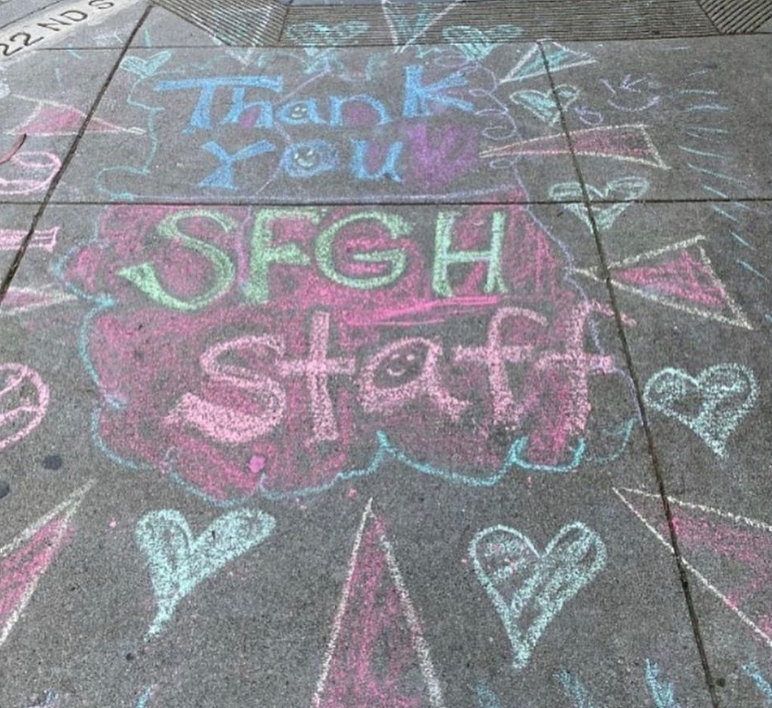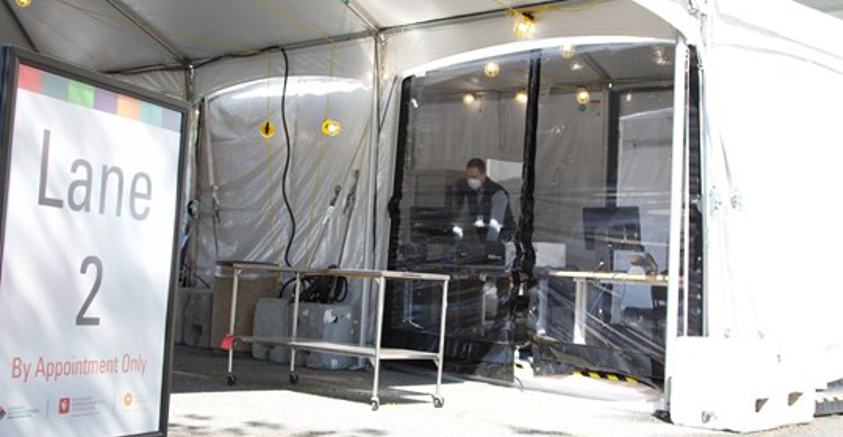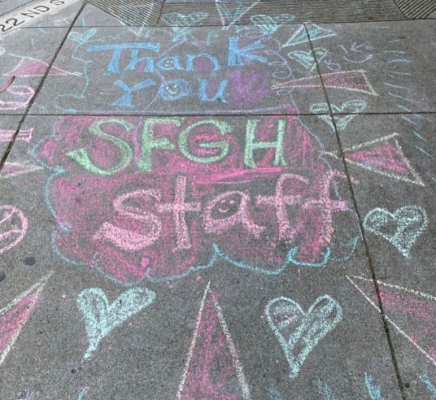
It wasn’t the first time Dr. Rachel Stern heard some of her primary care patients sharing wildly inaccurate, even dangerous advice about COVID-19.
As she conducted telephone visits to San Francisco Health Network patients in Mid-March, one man told her about a story he had heard – one promoted on Facebook as inside advice from a Stanford hospital board member, something that turned out to be a hoax. The Facebook post said “Taiwan experts” reported that if you could hold your breath for 10 seconds, you didn’t have COVID-19 “because if you can do so without coughing, discomfort, or tightness, it proves there is no Fibrosis [sic] in the lungs, basically indicates no infection.” Stern’s patient had been doing just that every hour. Another patient was sure he didn’t have COVID-19 because in addition to his fever and cough, he also had a runny nose.
Stern, a physician at Zuckerberg San Francisco General Hospital who is also an assistant professor of medicine at UCSF, patiently explained that wasn’t true. “It’s a stressful time, and a lot of patients are happy to hear from us and are very grateful to have someone to talk to and to check up on them. They also need safe, reliable information about the coronavirus,” she says. “What people all need to do is to stay home, stay away from other people and call a health professional if they develop symptoms of the illness. It’s all true but it’s so boring, and the rumors are so dramatic. People want something more exciting than being told to stay home and watch Netflix. Or something easier than choosing to lose their income because it’s too risky to go to work. But bringing patients the hard, boring truth is an important job right now.”
At the San Francisco Health Network, Stern has joined forces Keith Seidel, MD, SFHN’s COVID lead for primary care, and Henry Rafferty, MPA, SFHN’s primary care manager of population health and analytics, to ensure that the most vulnerable and at-risk patients don’t slip through the cracks during this emergency period. Here’s how they’re using telehealth and their Electronic Health Record tools to do innovative work during the crisis.
Building the Telehealth Foundation
Before the COVID-19 crisis, telehealth played only a small role in patient care at the San Francisco Health Network (SFHN). SFHN, the healthcare arm of the San Francisco Department of Public Health, includes two major hospitals and 45 clinics. This safety net hub serves hundreds of thousands of patients yearly, including a large percentage of patients with chronic diseases.
Rafferty notes that the network had implemented a few disease-specific examples of telehealth, such as tele-dermatology and a roving van with a retinal camera on which patients can obtain diabetic retinopathy exams. Diabetic retinopathy can cause blindness if uncontrolled, and it’s a struggle to find enough ophthalmologists and optometrists to screen everyone them for retinopathy. “The van is very helpful,” says Rafferty. “But it only serves a specific need for a specific condition. Before the outbreak, we did not even have a ‘telephone visit’ category in our Electronic Health Record.”
Everything changed with COVID. In less than week, the SFHN transitioned from doing thousands of in-person visits per day to doing thousands of telephone visits. The primary goal of these virtual house calls was to reduce the spread of COVID-19 in healthcare settings. However, SFHN saw other benefits. “It can be very taxing to get to an appointment,” Stern said, “especially if the patient is sick or lives far away. I had a call with one patient to give her test results – she lives 15 miles away and was so grateful not to have to drive into the city. I talked with another patient today, in fact, who I’ve never been able to track down before.”
The Innovation
Inspired by the United Kingdom’s National Health Service (NHS), SFHN decided to go beyond previously scheduled telephone visits to support patients at high risk for COVID complications. Before influenza season, NHS clinics reach out to patients with chronic diseases and offer them medication refills and basic disease counseling. This prevents high risk patients from coming to clinics for non-urgent needs, which reduces their exposure to influenza. San Francisco’s COVID lead for primary care and medical director of Southeast Health Center, Keith Seidel, MD, had worked in the NHS and immediately saw how it could be translated to addressing COVID.
Rafferty, Seidel and Stern built chronic disease registries for patients at high risk of COVID complications and developed a protocol, along with frontline staff at the Southeast Health Center, for medical assistants and other staff calling those patients.
Callers provide basic education about COVID, then ask some simple questions to help find out if a patient’s disease is poorly controlled — for instance, if a patient with diabetes is having symptoms of low blood sugar. All chronic disease patients are offered telephone appointments with their primary care provider. People with concerning symptoms are routed more urgently to a nurse.
Outreach has begun with patients who have heart failure, diabetes, asthma, chronic obstructive pulmonary disease and HIV. SFHN ultimately hopes to expand to patients with other immune- compromising conditions, kidney disease and children with chronic illnesses.
“We wanted to check in on people who were high-risk and vulnerable,” Said Stern, who is the medical director of two of SFHN’s Medi-Cal value-based care initiatives. “Also, a lot of our patients don’t speak English or have low literacy levels. We want to make sure they all have the support they need. Many of our safety net patients also need things like housing and food – when it’s feasible we’re offering those services through outreach too.”
On April 2, SFHN also opened on-site COVID-19 testing at Zuckerberg SF General Hospital.

Outdoor testing tent at Zuckerberg SF General (SFGH Foundation)
“Of course, we didn’t see this coming; otherwise we would have equipped all our patients with a glucometer and a scale,” said Rafferty. “But if patients are interested in, say, getting a home blood pressure monitor, we can arrange to have one shipped to their house. We’ve done a lot of work with our hypertensive population – teaching them to use blood pressure cuffs and so on – so we’ve laid the foundation.” As Stern reflects, “On a population level, it’s too early to tell what kind of effect our outreach will have, but it seems promising.”
In addition, there is a strong financial case for both telephone visits in general and outreach in particular. Federally Qualified Health Centers are struggling for revenue as they cancel outpatient in-person visits, and telephone visits are one of the only remaining sources of revenue. While providers don’t bill for the outreach, they are able to bill for the phone visits, which helps prevent a drastic shortfall in revenue.
Rafferty and Stern share that a critical part of this effort has been creating electronic chronic disease registries and teaching front-line staff how to use them. “We had a lot of [people] working on Excel spreadsheets; now we’ve had to teach an entire workforce how to use the tools embedded in the EHR,” said Rafferty. The one upside, Stern said, is that people see the value of these population health tools. “We’re getting to leverage stuff we’ve been working on since long before COVID to help patients in a time of crisis. Everyone seems really supportive: There’s a lot of energy in rolling out new things and getting staff buy-in.”
Stern agrees. “Obviously, these are hard days and doing something like this is a luxury,” she says. “If we were in New York City, every single healthcare professional would be caring for people with COVID. But flattening the curve means prolonging the emergency [restrictions], and eventually people with chronic illnesses are going to suffer. The longer normal healthcare operations are disrupted, the more likely chronic illnesses may be exacerbated. So I hope we can continue to check in on people to let them know we care.”
![]()
VOICES FROM THE FIELD: INNOVATING DURING THE COVID-19 CRISIS
This series is based on the extraordinary work that frontline health care staff are doing in the current public health emergency. Do you want to share a story about COVID-19 and the health care safety net? Please get in touch!
Find this useful or interesting? We’re constantly sharing stuff like this. Sign up to receive our newsletter to stay in the loop.


